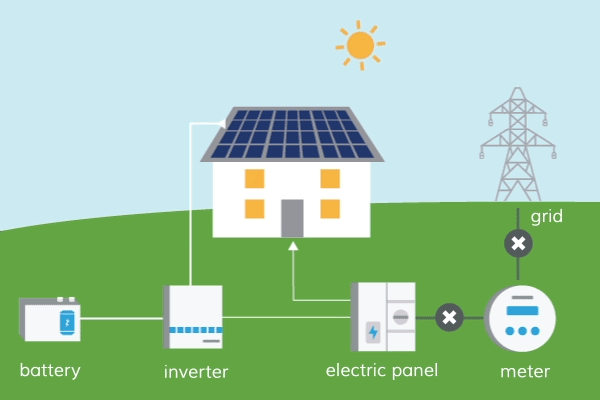Grid-Systems
ON – GRID SYSTEM
An on-grid solar system, also known as a grid-tied solar system, is a sustainable and environmentally friendly energy solution that converts sunlight into electricity using solar panels. Unlike off-grid systems that rely solely on stored energy in batteries, on-grid systems are interconnected with the local utility’s power grid. This integration allows for seamless bi-directional electricity flow, ensuring a stable and continuous power supply.
During sunny periods, the solar panels generate electricity, which can be used to power appliances and meet the electricity demands of the premises. Any surplus energy not immediately consumed is fed back into the grid, often through a process known as net metering. In net metering, the excess energy sent to the grid is credited to the consumer’s account, reducing their electricity bills and potentially even earning them compensation from the utility company.
Conversely, when solar panels are not generating enough electricity, such as at night or during overcast days, the on-grid system draws electricity from the grid to meet the consumption needs. This connection to the grid ensures a reliable power supply regardless of weather conditions or fluctuating solar energy production.
On-grid solar systems offer numerous advantages, including cost savings, as they help reduce dependence on expensive conventional energy sources. Additionally, these systems contribute to a greener environment by decreasing reliance on fossil fuels and lowering greenhouse gas emissions. Furthermore, they support grid stability by contributing clean energy to the overall power supply, enhancing the resilience and sustainability of the electricity grid.
As renewable energy technologies advance and governments encourage the adoption of clean energy solutions, on-grid solar systems continue to gain popularity among homeowners, businesses, and industries seeking a practical and eco-conscious approach to meet their energy needs.


OFF – GRID SYSTEM
An off-grid solar system is a self-sustaining and independent energy solution that generates electricity from sunlight using solar panels without being connected to the public power grid. This setup is ideal for remote or rural areas where grid connectivity is unavailable or costly. Off-grid systems typically incorporate energy storage in batteries, allowing excess solar power generated during sunny periods to be stored for use when the sun is not shining, such as during the night or on cloudy days.
In an off-grid solar system, solar panels capture sunlight and convert it into direct current (DC) electricity. The DC electricity is then sent to charge batteries through a charge controller, which regulates the charging process to prevent overcharging. The batteries store the energy for later use, acting as a reservoir to supply power during periods of low solar energy production.
To make the electricity usable for household appliances and electronic devices, an inverter is employed to convert the DC electricity stored in the batteries into alternating current (AC). The AC power can then be distributed throughout the off-grid property to meet the energy demands of the users.
Off-grid solar systems offer several advantages, including energy independence and reduced reliance on traditional energy sources, making them an environmentally friendly option. However, they also require careful planning and sizing to ensure they can meet the energy needs of the property throughout the year. Additionally, off-grid systems may involve higher upfront costs due to the inclusion of energy storage components like batteries, but they can provide long-term cost savings by eliminating monthly electricity bills and reducing dependence on costly diesel generators in remote areas.
HYBRID – SYSTEM
A solar hybrid system is a combination of both on-grid and off-grid solar setups, designed to provide a flexible and reliable energy solution. This system integrates solar panels, energy storage batteries, and a connection to the public power grid, offering the benefits of both on-grid and off-grid systems.
In a hybrid solar system, solar panels convert sunlight into electricity, which can be used to power appliances and meet the energy demands of the property. Excess solar energy generated during sunny periods is stored in batteries for later use when solar production is low, such as during the night or on cloudy days. This energy storage capability allows the system to function independently, similar to an off-grid setup, providing uninterrupted power supply even during grid outages.
The hybrid system is also connected to the grid, allowing homeowners to draw electricity from the grid when solar energy is insufficient to meet the demand or during periods of high consumption. Conversely, when the solar panels generate surplus energy, it can be fed back into the grid, potentially earning credits or compensation through net metering.
Hybrid solar systems offer several advantages, including energy independence, increased reliability, and the potential for cost savings. By using energy storage, users can reduce their reliance on the grid during peak hours when electricity rates are higher, helping to lower electricity bills. Moreover, the integration of renewable energy sources with the grid contributes to a more sustainable energy ecosystem, reducing carbon emissions and supporting overall grid stability.
The versatility of hybrid solar systems makes them a popular choice for areas with intermittent grid access or unstable electricity supply. They offer an optimal balance between self-sufficiency and grid connectivity, providing a greener and more resilient energy solution for residential, commercial, and industrial applications.

